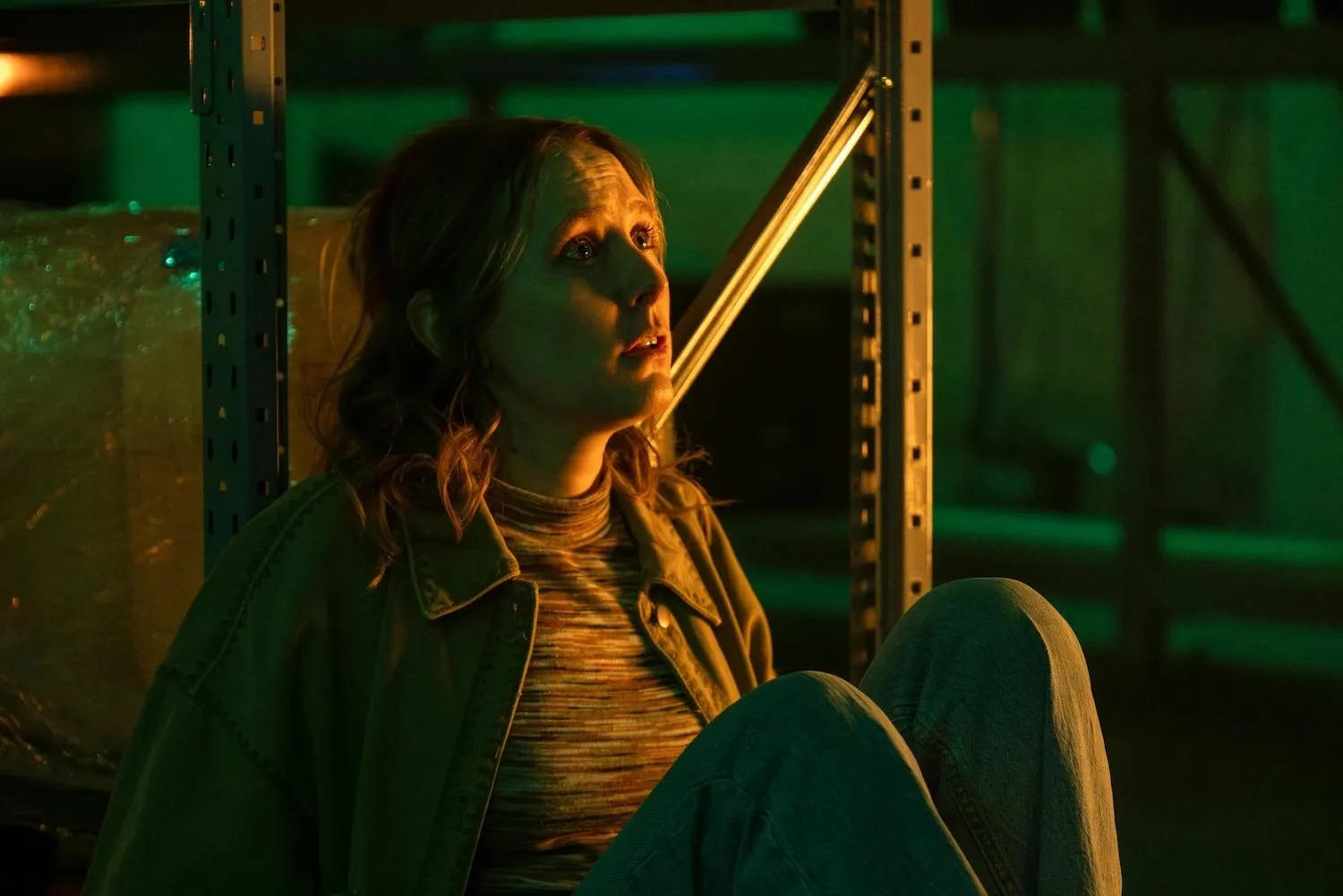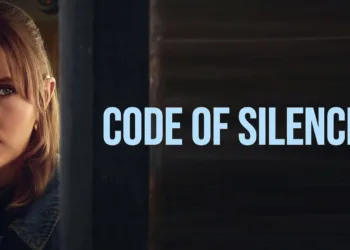From its very first frame, Code of Silence seizes attention by reframing the well-trodden police thriller through a seldom-seen perspective. What begins as a routine surveillance operation quickly turns into a compelling study of perception, communication, and power—an engagement with crime drama that feels both fresh and urgent.
Code of Silence is a six-part series premiering on ITVX/ITV1, each episode running approximately fifty minutes. At its heart is Alison Brooks (Rose Ayling-Ellis), a cafeteria worker at a Canterbury police station whose extraordinary lip-reading skills land her a spot on a high-stakes undercover investigation. When detectives discover her talent, Alison shifts from serving tea to decoding the clipped, conspiratorial exchanges of a violent gang.
The action alternates between the cluttered operations room, the quiet intensity of hidden-camera footage, and the pub where Alison takes a side-job to shadow the gang’s newest recruit. These locales—the austere police station, sunlit streets of Canterbury, and a dimly lit bar—become stages for a cat-and-mouse game, underscored by the tension of what is heard versus what is understood.
This series matters not only for its twist on genre conventions but also for placing a deaf woman at the narrative’s core. In doing so, it challenges entrenched ideas about who can lead a crime drama and how stories about power, access, and justice are told.
Building Momentum: Structure and Pacing
Code of Silence unfolds with the precision of a scalpel, each fifty-minute episode sharpening tension before slicing through to the next reveal. Episode one introduces Alison Brooks’s leap from mundane canteen duty to surveillance specialist—an inciting incident that hooks viewers by juxtaposing quiet routine and sudden peril.
By the midpoint of episode three, a subtle twist reorients loyalties: information gleaned in fractured lip-reading sessions forces Alison—and us—to question who holds the real power. The finale detonates with a payoff that reconfigures every hint dropped along the way, rewarding attentive streaming-room detectives and casual viewers alike.
The main heist investigation threads tightly through all six chapters, but it never monopolizes screen time. Subplots—Alison’s fight to keep her council flat, her tense mother-daughter bond, and the fraught attraction with Liam—surface in quieter scenes, grounding the thriller’s adrenaline in human stakes. These counterpoints create breathing space, allowing empathy to swell before the next plot thrust.
Suspense is engineered through deliberate withholding. Cliffhangers at each episode’s close leave lip-reading fragments unresolved—viewers piece together meaning alongside Alison, fostering an active form of engagement uncommon in passive streaming binges. Text overlays appear and recede like fragmented memories, delaying clarity until the story’s internal logic demands it.
Pace surges during pub chases or claustrophobic stakeouts, where rapid cuts mimic Alison’s escalating heartbeat. Then the action pauses for intimate character beats—her sighs over unread subtitles or furtive glances at CCTV screens—slowing tempo so emotion registers fully. This ebb and flow echoes real-world conversations about accessibility and attention in an era of endless content, reminding us that thoughtful pauses can be as vital as plot propulsion.
Complex Human Portraits and Transformative Performances
Rose Ayling-Ellis’s portrayal of Alison Brooks charts a vivid emotional journey: from cafeteria bystander to resourceful investigator whose very identity reshapes the investigation. In early scenes, vulnerability ripples across her face—hesitant glances, measured hesitations—yet as she deciphers grainy CCTV lip-reads, her posture tightens with purpose. That blend of uncertainty and resolve underscores Alison’s inner conflict: she’s driven as much by necessity—her family’s impending eviction—as by genuine curiosity about a world that previously excluded her.
Kieron Moore’s Liam enters as an almost archetypal reluctant criminal, shoulders slumped and expression guarded. But Moore infuses him with subtle warmth—flickers of guilt in his eyes when Alison reads him, moments where he seems torn between loyalty and conscience. Their chemistry crackles in shared silences: a half-smile when their gazes meet, a brief touch that suggests redemption might not be just a narrative convenience but a real possibility.
Andrew Buchan’s DI James Marsh embodies the haunted leader archetype, his measured authority tinged with personal regret. He offers Alison professional respect, yet his wariness reveals a deeper insecurity about the limits of institutional power. By contrast, Charlotte Ritchie’s DS Francis is all caution and protocol—her brisk decisions clash with Alison’s improvisations. Their reluctance to fully embrace Alison’s methods reveals the industry’s own resistance to change.
At home, Alison’s dynamic with her mother—equally deaf and equally driven—anchors the drama in lived experience. Late-night strategy sessions at the kitchen table double as financial planning, illustrating how economic precarity shapes both risk-taking and familial bonds.
Even supporting characters carry weight: canteen colleagues who dismiss Alison’s ambitions too quickly; gang members whose faces shift from threat to vulnerability when seen through Alison’s empathetic lens. These performances, layered and interwoven, reflect a shift in television toward characters whose flaws and strengths arise from real-world pressures, rather than tropes alone.
Beyond the Heist: Themes and Representation
In Code of Silence, disability isn’t an add-on; it’s woven into the series’ DNA. The show’s depiction of hearing loss transcends cursory nods, using inventive sound design to place viewers inside Alison’s world—dialogue emerges as muted thuds, ambient noise warbles like a distant radio, and words materialize in fractal text before resolving. This approach doesn’t just dramatize lip-reading mechanics; it exposes everyday barriers. When subtitles lag or misalign, we share Alison’s frustration, a reminder that accessibility isn’t optional but essential to equity.
Economic precarity pulses through every scene, a subtle current beneath the crime narrative. Alison’s council-estate flat, threatened by corporate redevelopment, stands in stark contrast to the gilded bars and gleaming police precinct. Poverty isn’t romanticized; it’s portrayed as a catalyst for risk. Her side-gig at the pub isn’t glamorous night-life—it’s survival. When she leverages her talents for extra cash, it feels both resourceful and necessary, underscoring how financial strain shapes moral choices in ways that pure thrillers often ignore.
Gender and agency receive a bold overhaul here. Alison’s gaze asserts desire as a facet of her character, not a gratuitous plot device. Her sexual confidence collides with crime-drama tropes, prompting a role reversal: the female lead isn’t a damsel in waiting but the active pursuer. In scenes where detectives recoil at her unorthodox methods, we glimpse television’s lingering reluctance to embrace female autonomy—especially for disabled women. Yet Alison charges ahead, her agency a provocation to industry norms that too often sideline unconventional heroines.
A tug-of-war between legality and justice propels her ethical dilemmas. Pursuing Liam, she straddles the thin line separating surveillance from intrusion. Each revelation pits her compassion against protocol, forcing us to ask: is the pursuit of truth always righteous? As Alison deciphers clashing loyalties, the series challenges viewers to weigh the letter of the law against the spirit of justice, highlighting how personal stakes can rewrite institutional codes.
Crafting Perception: Aesthetic and Technical Mastery
Code of Silence turns every technical choice into a narrative device, inviting viewers to inhabit Alison’s world rather than merely observe it. Cinematographer Neil Shawcross favors tight framing during surveillance sequences, pressing faces and body language into the foreground so that even a twitch of an eyebrow becomes a clue. These claustrophobic shots contrast sharply with sweeping drone views of Canterbury’s cathedral spire and pastel-roofed streets—reminders that Alison’s keen gaze operates within a world larger than the police station’s four walls.
Sound design emerges as the series’ unsung hero. Ordinary dialogue is filtered through muffling filters and low-frequency rumbles, approximating Alison’s partial hearing and flipping our expectations about “full” audio fidelity. In the pub, lively music—fictional craft-beer anthems, no less—serves a dual role: it underscores the setting’s authenticity while dramatizing the extra layer of effort Alison expends to lip-read over clinking glasses. It’s a clever irony that a show about speechless communication pays such close attention to what we hear.
Visual text effects are another inventive flourish. Early on, subtitles shatter like fragmented glass—letters scatter and realign into coherent lines only when Alison’s perception clicks. This technique doesn’t just look cool; it makes us complicit in the act of translation, reminding us how often we take seamless dialogue for granted. Occasional on-screen diagrams—arrows pointing to lip movements, facial microexpressions highlighted—feel part educational tool, part stylistic wink at crime-drama conventions.
Editing and direction work hand in glove to modulate tempo. Rapid cross-cuts during stakeouts ratchet up tension, the brisk pace echoing Alison’s accelerating pulse. Yet director John Hayes pauses deliberately for quieter, character-driven beats: a single lingering shot on Alison’s face as subtitles crawl in late, or a wide frame of her and her mother strategizing over bills. These tonal shifts—between breakneck pursuit and reflective stillness—mirror bigger conversations about accessibility and attention in an age of endless streaming choice.
Shifting the Dial: Cultural and Industry Impact
Code of Silence stakes a bold claim: a deaf actor at the center of a mainstream crime thriller isn’t novelty—it’s overdue. By entrusting Alison Brooks’s journey to Rose Ayling-Ellis, ITVX signals an industry awakening to stories long sidelined. The series reframes disability not as a limitation but as an intrinsic narrative force, demonstrating that authentic representation can drive suspense and empathy in equal measure.
This casting choice could ripple through production halls worldwide. When a high-profile platform commits resources to a lead whose lived experience shapes every beat, it sets a precedent for hiring disabled writers, directors, and crew members. In an era where audiences demand authenticity—whether in ethnic, gender, or ability representation—Code of Silence suggests that inclusive storytelling is not a risk but an opportunity to deepen narrative complexity.
Viewers craving more than procedural puzzles will find themselves equally invested in Alison’s personal stakes. Crime-drama aficionados binge for plot twists; socially conscious audiences tune in for unvarnished portrayals of marginalization and resilience. The result is rare: a series that crosses interest groups without compromising on either intrigue or integrity.
Streaming amplifies this impact. With availability on ITVX in the U.K. and BritBox in North America, Code of Silence enters living rooms far beyond Canterbury. Global subscribers now glimpse how British television is evolving, potentially inspiring similar projects in the U.S., Australia, and beyond.
Unresolved threads—Alison’s career crossroads, Liam’s moral trajectory, the looming eviction battle—tease a second season. Should it arrive, the show may well cement its role as a bellwether for television’s next wave: one where diversity of voice reshapes not just who tells stories, but how.
Final Reflections and Verdict
Code of Silence thrives on its rare combination of authentic perspective and classic thriller momentum. Rose Ayling-Ellis anchors the series with a performance that balances quiet determination and palpable frustration, while the innovative sound design and text-driven visuals deepen our empathy. The heist narrative remains engaging, and the interwoven personal stakes—family pressures, moral quandaries—ensure emotional resonance beyond mere plot mechanics.
Yet the series isn’t flawless. A few storyline threads feel underexplored, and some establishing shots betray modest production resources. At times, the pace lags when subplots overstay their welcome, momentarily diffusing the suspense.
For viewers drawn to character-driven crime dramas and those seeking meaningful representation, Code of Silence offers both thrills and substance. With unresolved arcs around Alison’s future, Liam’s redemption, and the family’s housing crisis, there’s genuine anticipation for a second season that could build on this trailblazing start.
Code of Silence is a six-part British crime drama that premiered on ITV1 and ITVX on May 18, 2025.
Full Credits
Directors: Diarmuid Goggins, Chanya Button
Writers: Catherine Moulton, Will Truefitt, Benji Walters
Producers: Joseph Shrubb
Executive Producers: Rose Ayling-Ellis, Catherine Moulton, Tom Leggett, Damien Timmer, Elisabeth Murdoch, Stacey Snider, Jane Featherstone
Cast: Rose Ayling-Ellis, Kieron Moore, Charlotte Ritchie, Andrew Buchan, Nathan Armarkwei Laryea, Joe Absolom, Beth Goddard, Andrew Scarborough, Fifi Garfield, Rolf Choutan
The Review
Code of Silence Season 1
Code of Silence stands out as a smart, socially conscious thriller that marries traditional crime drama with groundbreaking representation. Rose Ayling-Ellis delivers a magnetic lead performance, supported by inventive sound and visual techniques that pull viewers into Alison’s world. While a few subplot stretches and modest production moments slightly temper the momentum, the series’ emotional depth and cultural significance outweigh its flaws.
PROS
- Authentic depiction of deafness through sound design and lip-reading visuals
- Rose Ayling-Ellis’s performance balances vulnerability and agency
- Tightly woven crime plot with human stakes
- Nuanced class commentary via Alison’s economic pressures
- Fresh gender dynamics with a proactive female lead
CONS
- Occasional pacing lulls in secondary storylines
- Some subplots feel underdeveloped
- Modest production values in a few establishing shots



















































